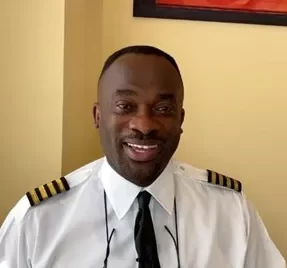- Captain Victor Kwesi Amoah, an aviation motivator, in an exclusive with B&FT highlights another episode of aviation history.
These are highlights the interaction:
Your monthly theme started with ‘Chaos Over’; how and why do you describe a post-World War event as chaotic?
Talking about chaos, I am not referring to murders, wars and killings. What I meant was that aviation had started in little pockets, in little places, in Europe and America. All the things were done in remote areas where at the time it was not even called an airport. People were doing little things in their little corners, so to speak.
Mind you, such business as air-freighting all sizes of cargo was very lucrative since there were no electronic ways of sending documents across. Internet was non-existent, and considering the vast land mass of the United States of America, this business was just a ‘God-send’.
Europe on the other side of the globe kept indulging in air-racing competitions to outcompete each other in devices that could set and break altitude, speed and distance records. Question; how was that achieved and measured? Whenever people went to air-parks, they were just going to see competition. The parks were designed like the race tracks of a stadium
Aircraft took off and flew something like a 400-metre race going round the field. Crowds gathered and cheered or booed depending on which side they were supporting; and officials took notes of the times, altitudes and distance covered by these aero-daredevils, and made official documentations. It was almost like football fans going to the stadium to view matches and indulge in all the euphoria that comes with it.
Such events over the weekends were people’s favourite past-times. Just like any fun fair outdoor event, businesses like food and beverage vendors, music providers, camera companies, mini-aviation shops to sell paraphernalia etc. cashed-in, while journalists present captured every fine detail of the event. It was a colourful occasion to aviation enthusiasts of the day. The air-parks were called Aero Dromus (Latin for Air races) and Aero Dromos (Greek for Air races).
Air meets (Airshows as we know them today) were also done when the climatic season permitted; and so many records were set and broken – as well as unsuccessful feats that ended up in fatalities for both the pilots and sometimes a section of the innocent crowd gathered. More on this in later features.
Toward the end of World War 1 and beginning of the early 1920s, with so many of records set and broken, causalities recorded, the air racing activity began to fizzle-out – giving way to commercial aviation when the idea was conceived to convert the surviving aircraft (from the First World War) for air freight and later on passenger services.
Some airlines like KLM established in1919, and Imperial Airways (British Airways of today) in 1924 were established after another idea – to fly passengers for a fee – was conceived.
The chaos in there was that though commercial services began with all the vim and vigour, so many questions needed to be addressed as to how safety of this business and economic viability were going to be realised.
Passengers were not fully assured of their safety – right from arriving at theses aero-parks to the flight itself and arrival at destination. Local regulations developed as and when suitable for the nations engaging in this aviation business; but to solve the chaotic puzzle, passengers – or the world for that matter – needed to know how safe an airport was. Passengers just drove to the airport, threw their baggage in the aircraft and emplaned. No formalities then (from arrival to the air-park to arrival at destination) as we know of today. How competent were the pilots? How authentic were the authorities who issued licences to the crew? How were the aircraft maintained?
Training, licencing and periodic refreshing of maintenance personnel and other operations supporting crew were some of the multitude of questions that needed satisfactory answers. There were times nations liked to fly their aircraft into other territories for business – but would not allow other nations to do the same to their territories. Pilots were not certain as of then who had the right of way when they came to head-on collisions – both taxiing on ground and operating in flight. How do we identify a missing aircraft? How do we investigate aircraft accidents? What formalities do passengers have to go through from arrival at the air-park to disembarking at their destination; and how was their security throughout their flight experience assured?
The above, I believe, describes the rather chaotic situation that existed as commercial aviation developed – since there were no internationally accepted regulations to address many aspects of aviation when commercial business began.
There were laws in America binding how airmail was going to be conducted; and it was out of awarding contracts for certain people to carry airmail that such airlines as TWA, United Airlines came to be. Those airmail services. In spite of all the local laws in America and Europe, they still didn’t solve the chaotic puzzle. What was needed to call off the chaos, was to bring all legal stakeholders from around the globe to sit and agree on all matters affecting commercial aviation.
Were there regulations prior to World War I? If no, how were the Aero daredevils going about their competitions?
Prior to World War I there were no established regulations that ruled the aero-daredevils…it was more like a hobby. The aero-daredevils were just out there to outcompete. It looked more of a hobby than an institution. Research, design, testing, documenting results of the subject matter were more of what existed in that era, rather than an insistent need or call to establish internationally accepted regulations. There was an attempt at the 1910 Paris convention, but not insistent enough to force implementation.
Today, we see civilised institutions, civilised set-ups and regulatory frameworks (internationally and locally). All these things were being done at aero-parks or aerodromes where people went to witness air-races.
During World War I they were not fully established. No concrete, internationally accepted regulations.
With the onset of commercial aviation toward the end of 1919 and into the early 1920s, internationally accepted regulations began to creep in. It started with the Paris Convention of 1919 – which basically attempted to institute the common regulations of civil aviation and laid the foundations of Air-law. It stated inter alia that each nation has absolute sovereignty over the airspace overlying its territories and waters. Nine years prior in 1910, there was a diplomatic conference to consider formulating international law about aviation – but it did not gain any international substance.
An event by name ‘Chicago Convention’ came to the rescue. What was that event? What did it do? How did it impact the evolution of aviation?
Stay tuned!










